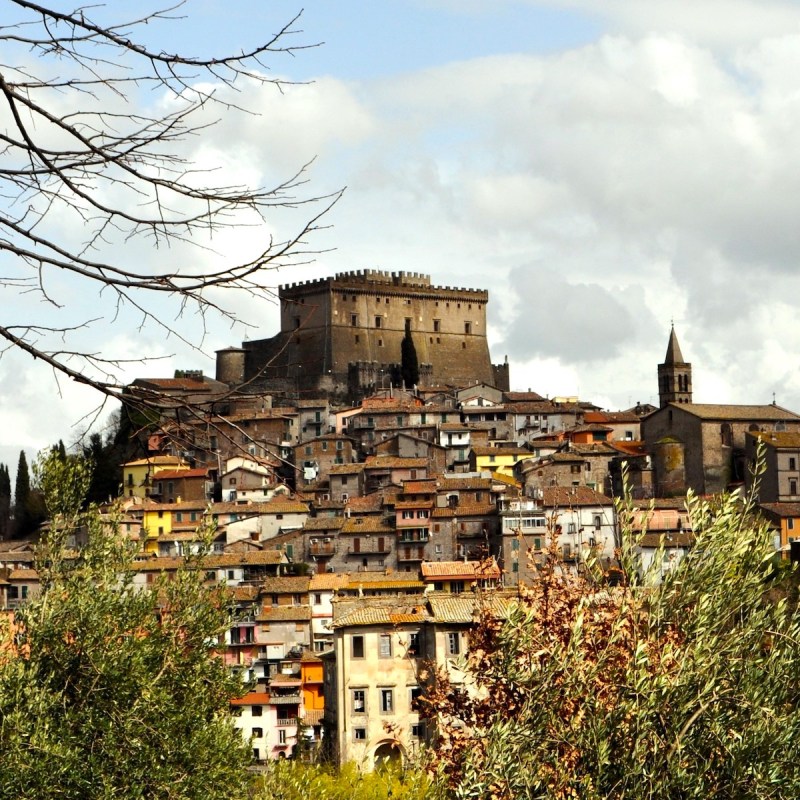
After a night in Sorrento and a day in Pompeii, we drove to Soriano Nel Cimino, our favorite base in Italy.
Videos by TravelAwaits
As a small, picturesque charmer with lots of history, the town not only gave — and gives, as we have a timeshare space there — us the chance to experience Italian life but also to explore the province of Viterbo in Central Italy. It helps that our room is in an old castle! Furthermore, it allows us to revisit Rome and Florence in just one trip.
Soriano is one of my favorite places in Italy. Here are the reasons why.

1. It Is A Small, Idyllic Italian Town
Imagine a town overlooked by one of the highest peaks in the Monti Cimini range. Breathtaking! Down the valley, before dining at the excellent restaurants around (we found one where we had to return a second night), you can walk around the Fontana Vecchia (“Old Fountain”), built in the 15th century, and the Porta Romana, a replica of the Porta Pia in Rome. You will be surprised to find three lovely places of worship for its 8,000 residents: the small Romanesque Chiesa di San Giorgio, built in the 11th century; the Chiesa di Sant’Eutizio, built in the 15th century; and the Cathedral of San Nicola di Bari, built in the 18th century.
One afternoon we wanted to get the best vantage point for an iconic picture. When we found it, we realized we did not bring our tripod with us. Luckily, a sweet old man walked by. He spoke no English but understood our dilemma and gladly took our picture. We went on to peek at lovely Italian homes and gardens, found winding cobbled alleys on hills, and spotted one of the tiny sidewalk gas stations Italy is known for. The flowers about town reminded us that it was still spring, and the small fruit and vegetable shops, as well as the little grocers and bakers, gave us a good taste of life in Italy. We even discovered a small eatery (just four seats) behind one of the stores and loved their homemade meatballs and spaghetti. And, of course, a local gelato was easy to find afterward.
Pro Tip: It would be good to schedule your visit during Sagra delle Castagne, or the Chestnut Festival, that Soriano is known for. It runs from the end of September until the beginning of October.

2. It Has A Long And Eventful History
At the town’s highest point stands the Orsini Castle. Built by Orso Orsini in the 13th century, the castle was the summer residence of Pope Nicholas III, Orsini’s uncle. It became a high-security edifice until the 1990s, and today it is managed by the University of Viterbo as a tourist attraction.
After imagining the past splendor of Orsini Castle’s courtyard and great room, as well as visiting its dim prison cells, we navigated a small circular stone staircase fit for one. From the castle top, we saw the town’s history expanding outward.
Soriano nel Cimino’s history can be traced back to the Etruscans, a pre-Roman civilization first mentioned by the Roman historian Livy — who wrote that in 443 BC, the Etruscans were “easily defeated” by the invading Romans. The area, especially near the neighboring town of Bomarzo, is full of Etruscan inscriptions, tombs, and medieval ruins connected by trails in a 4-hour hike.

3. You Can Sleep In A Castle
We stayed in a castle called Palazzo Catalani, part of our timeshare network of 300 resorts worldwide. It’s a small 14th-century castle of marvelous architectural design and delightful decor that blend Renaissance style with Roman elements. To get there, we could walk up either of two winding cobbled pathways from parallel streets to the top of the small hill where the castle is located.
Our room was an astonishing studio with original murals, large antique furniture, and more period decor. It was conveniently located right beside the reception office and the well-appointed bar. We even had a small kitchen where we prepared breakfast in the mornings and cocktail food some nights. (We had our first evening’s dinner at an a la carte restaurant serving delicious Italian specialties and other European dishes.) The sauna and heated pool soothed us in preparation for our night’s rest. But it was the excellent customer service from the highly experienced staff that we cherished most.

4. It Is A Great Base For Exploring Viterbo
Soriano is also a great base for exploring the province of Viterbo, which, being so close to Rome, is a great place to see the deep influence on Italian life the Roman Catholic Church has always had and will continue to have. Here are three fanciful old-world towns worth visiting — as well as the provincial capital, Viterbo, once a Papal Seat.
Civita Di Bagnoregio
Civita di Bagnoregio is 75 miles north of Rome and 45 minutes from Soriano. Its striking position will amaze you: atop a small plateau of volcanic tuff overlooking the Tiber River valley. Its edges began to fall (and continue to fall) when a major earthquake happened at the end of the 17th century. As the pace of erosion quickened two centuries later, it became a spectacle of an island hill, leaving buildings on its edges to crumble.
Its population is now just 12 during winter (about 100 during summer), but it is so wonderful to explore because its relative isolation has left its non-edge architecture unaltered. In 2006, it was placed on the World Monuments Fund’s Watch List of the 100 World’s Most Endangered Sites.
Civita and Bagnoregio used to be parts of the same town until the bishop and the municipal government relocated to the village in the valley after the earthquake.

Montefiascone
Montefiascone lies around Lake Bolsena, a caldera (or large volcanic crater) that formed in the Vulsini Volcanic Complex. Fifty-nine miles north of Rome and 30 minutes from Soriano, the town has numerous camping sites and bed and breakfasts. But its crowning glory is the Montefiascone Cathedral, also known as the Basilica of Santa Margherita, which has the fourth largest dome in Italy, behind the Pantheon, St. Peter’s Basilica, and Florence’s Duomo. It really looked like the whole church was under the dome.
Caprarola
The third town we visited was Caprarola, just 31 miles northwest of Rome and 25 minutes from Soriano, also sitting in the Cimini range of volcanic hills. I wanted to see the massive pentagonal-shaped Villa Farnese (not to be confused with the Palazzo Farnese in Rome). The Rennaissance villa was planned in 1530 to be a fortress to protect Cardinal Alessandro Farnese, but construction was discontinued when he was elected Pope in 1534 as Paul III. His grandson commissioned the construction of an estate on the completed pentagonal base.
Villa Farnese dominates the entire town, and everything was rearranged so that the main road leads directly to it. Each room is filled with oversized murals, and I was happily surprised to find that the Philippines (identified as Philipina) was on the Asian map in the Room of World Map. The maps were painted in the 1570s and depict cartographers’ understanding of the Earth at the time.
Viterbo
The capital, Viterbo, lies 50 miles north of Rome and 20 minutes from Soriano. Its historic center is surrounded by medieval walls, still intact, with ancient gates as entrances. They were built during the 11th and 12th centuries. In the 14th century, Viterbo became a Papal Seat and part of the Papal States. In fact, four Popes were elected in Viterbo. But when a foreigner got elected, the townsfolk invaded the Papal Palace while the longest conclave in history was being held. Two Cardinals were arrested. After this incident, Popes began to avoid Viterbo, and the city fell to secondary importance.

5. Florence And Rome Are Easily Accessible
Saving the best for last. Because Soriano is just 8 miles from the A1 Motorway, right smack in the middle between Rome and Florence, it was convenient to visit the two must-see cities of Italy. Rome is just an hour away by train, and Florence is two hours away by car. While it’s always fun to see the Roman Forum, the Colosseum, Trevi Fountain, the Pantheon, the Vatican, and the Spanish Steps, there are still many piazzas and attractions to discover. And although we have been to Florence’s Accademia, the Duomo, Santa Croce, and the Leather School, we still have the Uffizi, Palazzo and Ponte Vecchio, wineries, and more to explore.
We hope to go back to Italy when we resume flying. We have missed our room in Palazzo Catalani, and there are always new things to discover in Viterbo. Besides, this is truly the best base from which to revisit Rome and Florence in one trip.
Related Reading:
- 9 Amazing Things To Do In Rome, According To Locals
- 9 Fantastic Things To Do In Gorgeous Florence, Italy
- The Medieval Italian City Where Paper Is Still Created By Hand
- Cinque Terre Vs. Amalfi Coast: 7 Key Differences To Know Before You Go
- 7 Reasons You’ll Fall In Love With This Less Expensive Region Of Italy

